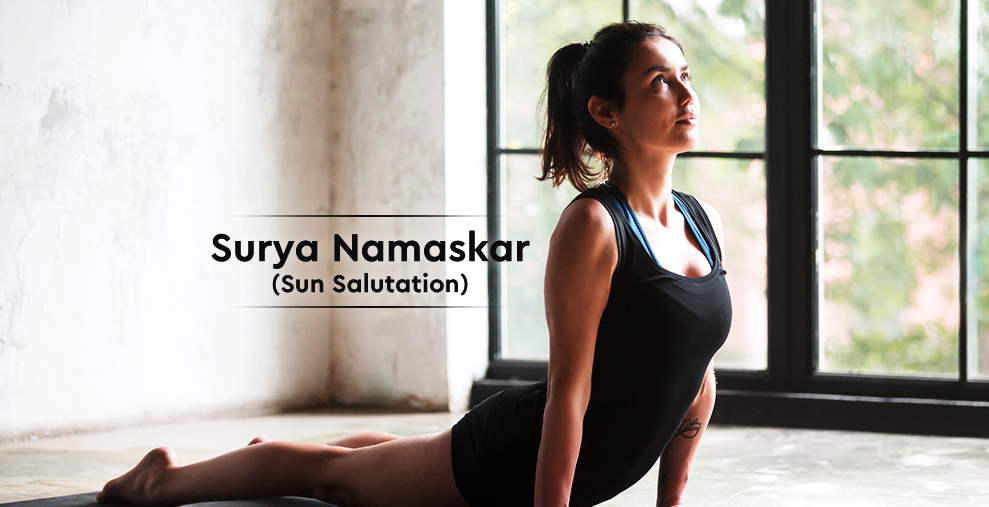Keep your face to the sun & you will never see the shadows.” – Helen Keller
The above statement alone emphasizes the positivity rendered by the Sun in our lives and also our minds!
We all know that the sun is the supreme energy source that sustains life on the earth. The ‘Sun’ or ‘Surya’ is perceived as a hot ball of gases that emit light. The entire food chain right from the primary producers (plants and herbs) to the apex predators (vultures etc.) is powered by the sun alone. Sun is also the most abundant and promising energy source due to the development in different ways of harnessing it for large scale use.

It is simply impossible to imagine life on the earth without the sun. And thus, the ancient Hindu civilizations were worshippers of the personalized form of the Sun or ‘Surya Devata’ (the Sun deity). This is how the dynamic sequence of ‘Sun Salutation’ or the “Surya Namaskar’ was brought into practice and has been practiced globally for thousands of years!
The Surya Namaskar consists of 12 main steps which have been discussed below in detail. The first four steps are also the last four steps in the descending sequence.
1. ‘Pranam Asana:
‘Pranam’ is the usual greeting with folded hands and ‘Asana’ refers to the term ‘pose’. Thus, the Pranam Asana is also known as the ‘Prayer Pose’ in which we have to stand erect with folded hands (preferably facing the rising sun). This step, if practised effectively with straightened knees, provides better posture and also creates a meditative Yoga pose.
2. Hasta Uttanasana:
After the prayer pose, inhale deeply by lifting your hands in the air and tilt your head and raised hands to the back. ‘Hasta’ means ‘hand’ and ‘Uttanasana’ means raising, so this pose is also called the ‘Raised Arms’ pose. This pose strengthens the spine and eliminates most of the back-related problems.
3. Padahastasana:
The next step is to keep both the legs fixed and knees straight and bend down as much as possible to touch your hands to your feet. Thus, the name Padahastasana which is the asana of ‘Pada’ (legs) touching the ‘hasth’ (hands). It strengthens the legs, knees, spine and hands and facilitates the increased downward flow of the blood.
4. Ashwa Sanchalanasana:
Keeping the right leg fixed to the ground and looking up, stretch the left leg backwards and balance the body on your toes.This is also called as the Equestrian pose (an adjective form of Ashwa – Horse!). There is a significant benefit in the digestive organs.
5. Chaturanga Dandasana:
‘Chatur’ means Four and ‘Anga’ means Parts so we shift back the front leg to balance the body on the hands and toes (2 + 2 = 4 limbs!). It is the Vedic equivalent of the ‘plank’ pose. Many schools of Yoga practise the ‘mountain pose’ or Parvataasan here. The Chaturanga Dandasana pose is the best for enhancing endurance, strengthening the neck, controlling the blood sugar level and curing related diseases.
6. Ashtanga Namaskara:
The actual sun salutation follows after the Chaturanga Dandasana. As already discussed in the previous article, ‘Ashta-anga’ refers to 8 parts since in this namaskar pose, exactly eight parts of the body viz. 2 feet, 2 knees, 2 hands, 1 chest and 1 head all touch the ground. This pose strengthens the shoulders and limbs and also a unique sense of spiritual well-being when we prostrate on the ground in worship and gratitude to the mighty Sun God.
7. Bhujangasana:
Keeping both the hands and feet fixed on the ground, lift the head and the eyes upright. The pose resembles a hooded serpent and hence is called as the ‘Bhujang’ meaning ‘Snake’ or Cobra pose. The Bhujan Asana reduces belly fat
8. Adho Mukha Svanasana:
We balance the body on the hands and legs with the seat upside and the head arching inwards to form an inverted ‘V’ Shape. ‘Adho’ means inside and ‘Mukha’ means head. This pose is also called Parvatasan or Mountain pose. Just like the Chaturanga Dandasana pose, the Parvatasan pose works for enhancing endurance, strengthening the neck, controlling the blood sugar level and curing related diseases.
9. Ashwa Sanchalanasana:
Move the right leg ahead and look upright to come back to the Ashwa Sanchalanasana pose.
10. Padahastasana:
Keep both the legs fixed and knees straight and bend down as much as possible to touch your hands to your feet and face bowed.
11. Uttana hastasana:
Raise your hands and head upwards and arch them backwards.
12. Pranamasana:
Move the hands and head ahead to keep them straight for the Pranaamasana.

The Sun has different roles in our lives and so we have 12 different names of Surya Devata which are as follows :
- Om Mitraya Namah (Friend)
- Om Ravaye Namah (Praised)
- Om Suryaya Namah (Guide)
- Om Bhanave Namah (Beauty giver)
- Om Khagaya Namah (Sense Stimulator)
- Om Pushne Namah (Sustainer)
- Om Hiranyagarbhaya Namah (Creator)
- Om Marichaye Namah (Disease Curer)
- Om Adityaya Namah (Inspiration)
- Om Savitre Namah (Purifier)
- Om Arkaya Namah (Radiant)
- Om Bhaskaraya Namah (Illuminator)
Let us all make it a habit to practise the Sun Salutation (especially on Sundays, the Ravi-Sun Var – day) and pray to Surya Devata to bestow upon us his divine light of wisdom, good health and peace.
